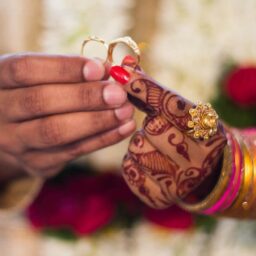Introduction
The customary solemnization of the uniting two persons and their families is frequently characterized and broadly acknowledged as marriage. It is legally described as the lawful union of a man and a woman as husband and wife, where they signed a contract that binds their belongings, income, and lives together till they live together as husband and wife. Marriage, or Vivaha, is a sacred vow between two persons for the survival and preservation of society through mutual aid and self-sacrifice when defined under personal law, such as Hindu law. According to Hindu holy texts, marriage is seen as a religious obligation for the Hindu community (Vedas). Hindu marriage is supervised in India by the Hindu Marriage Act of 1955, which covers all the elements of Hindu marriage from registration to dissolution. According to Section 2 of the Hindu Marriage Act of 1955[1], a marriage can be registered between a man and a woman who are Hindus, Sikhs, Buddhists, or Jains, or who convert or revert to these religions, or who are not Muslims, Christians, Parsis, or Jews. The evils and threats are present everywhere and if something good is there, then, we must have to prepare ourselves for something undesirable or a crime arising out of the same. Marriage is considered of sacrosanct nature in Hindus but the violations of the provisions do exist in the form of Bigamy, social evils like Child Marriage, cruelty, and numerous cases in hand.
Solemnization of marriage under Hindu law
According to the Hindu Marriage Act of 1955, certain prerequisites are set down in sections 5[2] and 7[3] to ensure that the marriage between two persons is lawful and valid. Marriage is declared valid under section 5 only if both parties are Hindu (as per section 2).
A marriage between any two Hindus may be solemnized if the following conditions are met:
- If neither party has a live spouse at the time of the marriage,
- If neither party is unable to give legitimate agreement to it due to mental incapacity,
- Despite their ability to give legitimate permission, none of them has suffered from any mental illness to the point of being unfit for marriage and childbearing.
- If none of them has ever had a recurring episode of mania or epilepsy.
- At the time of marriage, the bride has reached the age of 18 and the husband has reached the age of 21.
- Unless each party’s custom or use permits marriage between them, the parties are not within the degrees of prohibited relationship.
- Unless the custom or usage governing each of them permits marriage between the two, the parties are not lineal ascendants of each other (Sapindus).
Section 7: (1) A Hindu marriage may be solemnized using either party’s conventional rites or procedures.[4]
(2) When the Saptapadi (the taking of seven steps by the bridegroom and the bride together before the sacred fire) is included in such rites and ceremonies, the marriage becomes complete and binding at the seventh step.[5]
Offenses against Hindu marriage
Hindu marriage is a sacred ritual that has existed for decades, even though many people have committed offences that have distorted Hindu law principles. Marrying someone while already married to someone else is an offence known as Bigamy. Someone who engages in this behaviour is known as a bigamist. Any Hindu (as defined in section 2)[6] who violates section 5(i)[7] of the Hindu Marriage Act, 1955 is liable under Sections 494[8] and 495[9] of the Indian Penal Code (which imposes a sentence of imprisonment of any description for a period of seven or ten years, as well as a fine). Supreme Court in the case of Sarla Mudgal v. Union of India[10] laid down the principles against the practice of solemnizing second marriage by conversion to Islam, with first marriage not being dissolved. The verdict discusses the issue of bigamy, the conflict between the personal laws existing on matters of marriage, and invokes Article 44 of the Indian Constitution.
In today’s society, crimes like child marriage (marrying before reaching the legal age) are also prevalent. The bride child is the most vulnerable person in this marriage because of childbearing, rearing, domestic abuse, and a lack of parenting skills, and young brides are significantly more likely to be uneducated than unmarried girls. Child marriage is neither void nor voidable under the Hindu Marriage Act of 1955. Because of the legislature’s silence in Sections 11 and 12 and express rule in Section 13 (2) (iv)[11], the status of child marriage appears to be ambiguous under this act. However, In the case, T. Siva Kumar v. Inspector of Town Police Station Madhya Pradesh HC held that while a marriage contracted by a person with a female under the age of 18 is voidable and continues until the Court annuls it, the marriage is not valid in the strict sense, and the male does not have all of the rights that would otherwise arise from a marriage that is valid in the strict sense.
Apart from these Cruelty is also considered as an offence not only in Hindu law but also in common marriage. It can be used as a basis for divorce under section 13 of the Hindu Marriage Act, 1955, but it can also be used as a ground for punishment under section 498A[12] of the Indian Penal Code, which states that “Whoever, as the husband or a relative of the husband of a woman, submit such woman to cruelty shall be punished by imprisonment for a period of up to three years, as well as a fine.” In B.S Joshi v. The State of Haryana,[13] the Supreme Court concluded that the purpose of enacting this provision was to prevent a lady from being tortured by her husband or his relatives. Section 498-A was added to punish the husband as well as his family who harass the wife to satisfy illegal dowry demands.
Conclusion
Marriage is something that Hindu society believes is an eternal truth and something that is bound to have for seven births but what we ignore is that there is always a cloud behind the silver lining and we must accept this. Society should not believe that marriage is eternal but needs a relook. Marriage is between two individuals and the compatibility between them should decide the span. Forcing a marriage in the name of belief and culture is promoting crime in Hindu marriages. The acceptance of the crime and by tackling them only we can shift to a healthy marriage and we all must accept this and adhere to the same principle to stop the offences in the Hindu marriages.
Authors Name:
1. Riya Raj (Chanakya National Law University, Patna,)
2. Mayank Raj (Chanakya National Law University, Patna)
References:
[1] Hindu Marriage Act of 1955, s.2
[2] Hindu Marriage Act of 1955, s.5
[3] Hindu Marriage Act of 1955, s.7
[4] Hindu Marriage Act of 1955, s.7(i)
[5] Hindu Marriage Act of 1955, s.7(ii)
[6] Hindu Marriage Act of 1955, s.2
[7] Hindu Marriage Act of 1955, s.5(i)
[8] The Indian Penal Code,1960, s. 494
[9] The Indian Penal Code, 1960, s. 495
[10] 1995 SCC (3) 635
[11] Hindu Marriage Act of 1955, s. 13(2)(iv)
[12] The Indian Penal Code,1960, s. 498A
[13] (2003) 4 SCC 675














